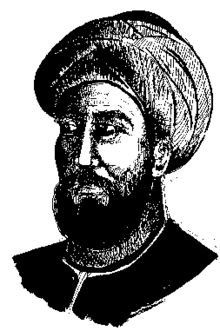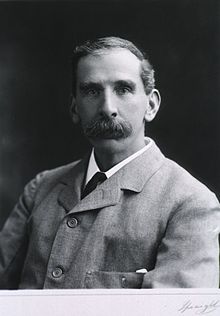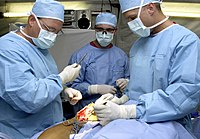Surgeon
In
In some countries and jurisdictions, the title of 'surgeon' is restricted to maintain the integrity of the craft group in the medical profession. A specialist medically trained surgeon is to be distinguished from surgeons in podiatry, dentistry, and veterinary medicine. It is estimated that surgeons perform over 300 million surgical procedures globally each year.[1][2]
History

The first person to document a surgery was the 6th century BC Indian physician-surgeon, Sushruta. He specialized in cosmetic plastic surgery and even documented an open rhinoplasty procedure.[3] His magnum opus Suśruta-saṃhitā is one of the most important surviving ancient treatises on medicine and is considered a foundational text of both Ayurveda and surgery. The treatise addresses all aspects of general medicine, but the translator G. D. Singhal dubbed Sushruta "the father of surgical intervention" on account of the extraordinarily accurate and detailed accounts of surgery to be found in the work.[4]
After the eventual decline of the Sushruta School of Medicine in India, surgery was largely ignored until the Islamic Golden Age surgeon Al-Zahrawi (936–1013) re-established surgery as an effective medical practice. He is considered the greatest medieval surgeon to have appeared from the Islamic World, and has also been described as the father of surgery.[5] His greatest contribution to medicine is the Kitab al-Tasrif, a thirty-volume encyclopedia of medical practices.[6] He was the first physician to describe an ectopic pregnancy, and the first physician to identify the hereditary nature of haemophilia.[7]
His pioneering contributions to the field of surgical procedures and instruments had an enormous impact on surgery but it was not until the 18th century that surgery emerged as a distinct medical discipline in England.[7]
In Europe, surgery was mostly associated with barber-surgeons who also used their hair-cutting tools to undertake surgical procedures, often at the battlefield and also for their employers.
Titles in the Commonwealth
In 1950, the
Military titles
In many English-speaking countries the
Specialties
- Cardiac surgery (in the United States considered part of cardiothoracic surgery)
- Colorectal surgery
- Craniofacial surgery
- Dental surgery
- Endocrine surgery
- General surgery
- Neurological surgery
- Obstetrics and gynaecology
- Ophthalmology
- Oral and maxillofacial surgery
- Orthopedic surgery
- Otorhinolaryngology
- Pediatric surgery
- Plastic surgery
- Podiatric surgery
- Surgical oncology
- Thoracic surgery (in the United States considered part of cardiothoracic surgery)
- Transplant surgery
- Trauma surgery
- Upper gastrointestinal surgery
- Urology
- Vascular surgery
Some physicians who are
In the United States, the Department of Labor description of a surgeon is "a physician who treats diseases, injuries, and deformities by invasive, minimally-invasive, or non-invasive surgical methods, such as using instruments, appliances, or by manual manipulation".[11]
Around the world, the array of 'surgical' pathology that a surgeon manages does not always require surgical methods. For example, surgeons treat diverticulitis conservatively using antibiotics and bowel rest. In some cases of small bowel obstruction, particularly where a patient has had previous abdominal surgery, the surgeon treats the patient with fluid resuscitation, nasogastric decompression of the stomach, which gives rise to resolution of the intestinal obstruction in cases where adhesions are the aetiology of the obstruction. The same is true for other craft groups in surgery.
Pioneer surgeons

- Christiaan Barnard (cardiac surgery, first heart transplantation)
- open heart surgeryin 1944)
- Nina Starr Braunwald (First female cardiac surgeon)
- Dorothy-Laviania Brown (First female African-American surgeon)
- Victor Chang Australian pioneer of heart transplantation
- Harvey Cushing (pioneer, and often considered the father of, modern neurosurgery)
- Eleanor Davies-Colley (surgeon and founder of the South London Hospital for Women and Children)
- Michael DeBakey (educator and innovator in the field of cardiac surgery)
- René Favaloro (first surgeon to perform bypass surgery)
- Svyatoslav Fyodorov (creator of radial keratotomy)
- Harold Gillies (pioneer of plastic surgery)
- Jesse Gray (First female chief of surgery at Hopkinz Hospital)
- William Stewart Halsted (initiated surgical residency training in U.S., pioneer in many fields)
- Michael R. Harrison (pioneer of fetal surgery)
- Sir Victor Horsley (neurosurgery)
- Dr. Jekyll.)
- Gavriil Ilizarov, inventor of the Ilizarov apparatus for lengthening limb bones and for the method of surgery named after him, the Ilizarov surgery
- Charles Kelman (Invented phacoemulsification, the technique of modern cataract surgery)
- Lars Leksell (neurosurgery, inventor of radiosurgery)
- open heart surgery")
- named in his honour)
- laparoscopic spine surgery.[12]
- Ioannis Pallikaris (Greek surgeon. Performed the first LASIK procedure on a human eye.[13] Developed Epi-LASIK.[14])
- epidural anesthesia)
- Wilder Penfield (neurosurgery)
- Gholam A. Peyman (inventor of LASIK,[15])
- field surgery)
- Jennie Simile Robertson (first female surgeon in Canada)
- Valery Shumakov (pioneer of artificial organs implantation)
- Maria Siemionow (pioneer of near-total face transplant surgery)
- Sushruta (the first to document an operation of open rhinoplasty[3])
- Paul Tessier (French surgeon in Craniofacial surgery)
- Mary Edwards Walker (first female surgeon in the United States)
- microneurosurgery)
- al-Zahrawi, regarded as one of the greatest medieval surgeons and a father of surgery.[16]
Organizations and fellowships
- ACFAS
- FACS
- FRACDS
- FRACS
- FRCS
- FRCS (Canada)
- FRCS (Edinburgh)
- FRCSI (Ireland)
- MRCS
References
- S2CID 24856780.
- (PDF) from the original on 2023-02-28. Retrieved 2023-02-28.
- ^ ISBN 1588905152
- ^ Singhal, G. D. (1972). Diagnostic considerations in ancient Indian surgery: (based on Nidāna-Sthāna of Suśruta Saṁhitā). Varanasi: Singhal Publications.
- S2CID 57308997
- ISBN 978-0-520-01532-6. Retrieved 16 May 2011.
- ^ ISBN 978-0-8160-4887-8.
- ^ "Surgeons and Surgical Spaces #The barbers shop". sciencemuseum.org.uk. Archived from the original on 2020-08-07. Retrieved 2020-05-05.
- ^ "Patients: The Surgical Team: Qualifications of a surgeon". Royal College of Surgeons of England. Archived from the original on 2 July 2015. Retrieved 13 June 2015.
- ^ "RACS phases out gendered titles for surgeons". Royal Australasian College of Surgeons. Archived from the original on 31 August 2021. Retrieved 31 August 2021.
- ^ "Occupational Employment Statistic: Occupational Employment and Wages, May 2015: 29–1067 Surgeons". bls.gov. Archived from the original on 2016-05-06. Retrieved 2016-04-26.
- ^ Basant Kumar Misra, President NSI 2008 Archived 2021-02-27 at the Wayback Machine. Neurological Society of India
- ^ Stuart, Annie (1 June 2009). "A Look at LASIK Past, Present and Future". American Academy of Ophthalmology. Archived from the original on 10 July 2016. Retrieved 2 July 2016.
- ^ "When Cornea Transplants Fail. What Next?" Harvard University. Archived 2006-09-09 at the Wayback Machine
- ^ Peyman, Gholam A. (1989) U.S. patent 4,840,175 "Method for modifying corneal curvature".
- PMID 12134355.


